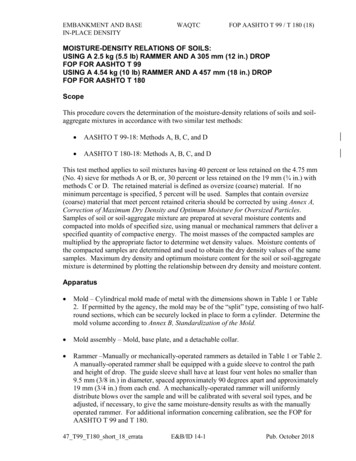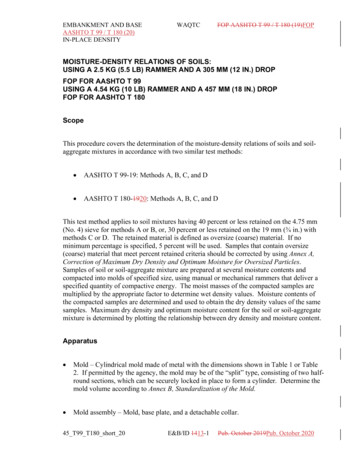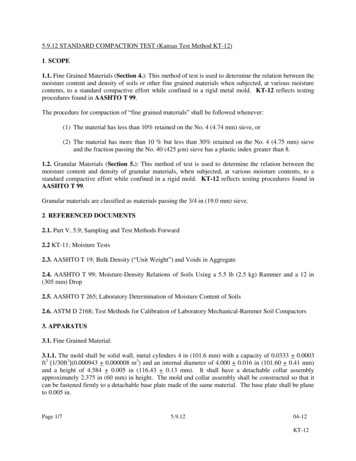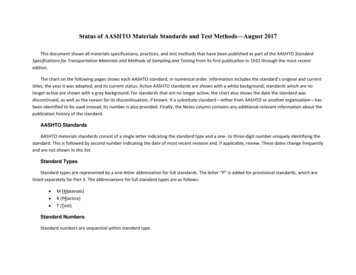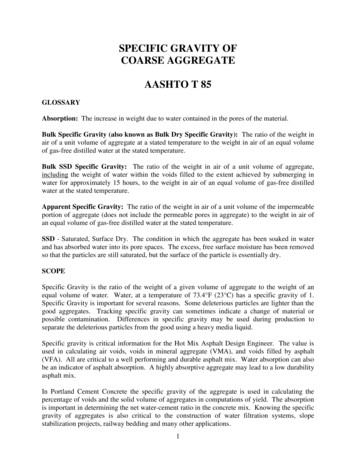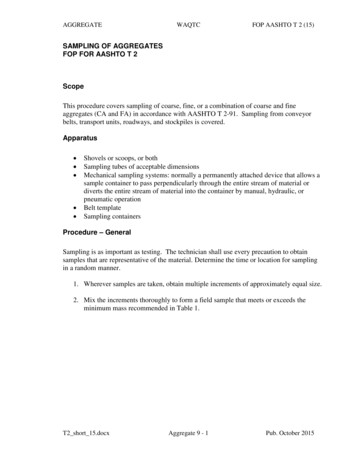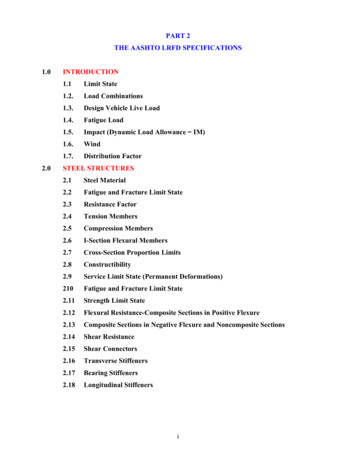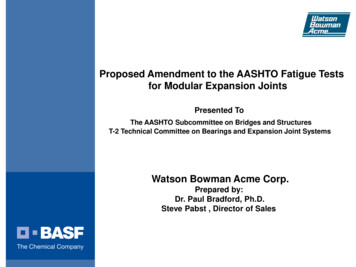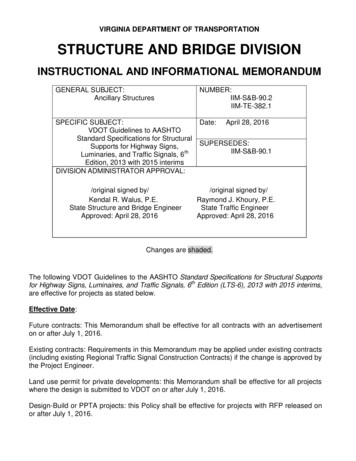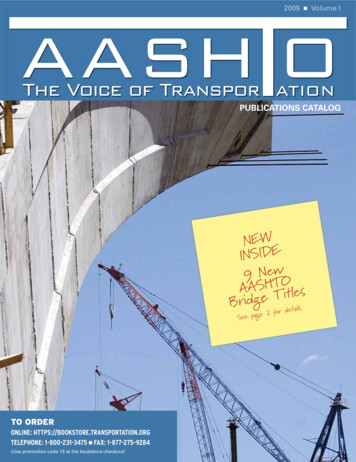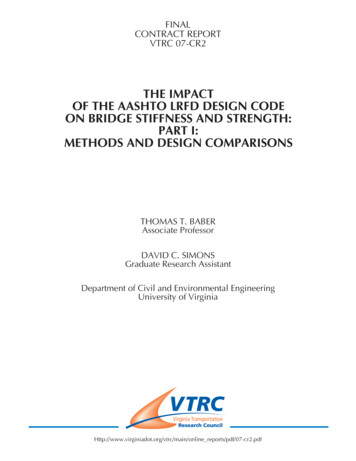
Transcription
FINALCONTRACT REPORTVTRC 07-CR2THE IMPACTOF THE AASHTO LRFD DESIGN CODEON BRIDGE STIFFNESS AND STRENGTH:PART I:METHODS AND DESIGN COMPARISONSTHOMAS T. BABERAssociate ProfessorDAVID C. SIMONSGraduate Research AssistantDepartment of Civil and Environmental EngineeringUniversity of e reports/pdf/07-cr2.pdf
1. Report No.:FHWA/VTRC 07-CR2Standard Title Page - Report on Federally Funded Project2. Government Accession No.:3. Recipient’s Catalog No.:4. Title and Subtitle:The Impact of the AASHTO LRFD Design Code on Bridge Stiffness andStrength: Part I: Methods and Design Comparisons5. Report Date:March 20076. Performing Organization Code:7. Author(s):Thomas T. Baber and David C. Simons8. Performing Organization Report No.:VTRC 07-CR29. Performing Organization and Address:Virginia Transportation Research Council530 Edgemont RoadCharlottesville, VA 2290310. Work Unit No. (TRAIS)11. Contract or Grant No.6955112. Sponsoring Agencies' Name and AddressVirginia Department of TransportationFHWA1401 E. Broad StreetP.O. Box 10249Richmond, VA 23219Richmond, VA 2324013. Type of Report and Period CoveredFinal Contract14. Sponsoring Agency Code15. Supplementary Notes16. AbstractThe Commonwealth of Virginia is currently transitioning from the long-used AASHTO Allowable Stress Design (ASD)specification to AASHTO’s Load and Resistance Factor Design (LRFD) specification. The new specification features revised liveloads, more conservative impact factors, a new load distribution method for analysis, and a probabilistically based limit state designapproach. Traditional deflection limits have been made optional in the LRFD format. The extensive changes in the specificationmake it unclear as to whether bridges designed using the LRFD specification will be more or less flexible than those designed usingthe ASD specification.A series of bridges were designed using both ASD and LRFD formats to investigate what, if any, significant changes in bridgeflexibility might be encountered and whether deflection limits are more or less likely to be violated with the LRFD format. Basedupon the design of six single-span bridges with varying spans and numbers of girders, and a partial design of a three-spancontinuous bridge, it was concluded that the LRFD designs tend to be lighter and more economical in general and also tend to bemore flexible than ASD designs of the same bridge. The weight savings appears to be more pronounced on single-span bridges thanon multiple-span bridges because of the greater significance of local and lateral stability concerns in the finished bridges for multispan bridges.17 Key Words18. Distribution StatementLoad and Resistance Factor Design, bridge design, bridge design No restrictions. This document is available to the public throughspecificationNTIS, Springfield, VA 22161.19. Security Classif. (of this report)20. Security Classif. (of this page)21. No. of Pages22. PriceUnclassifiedUnclassified76Form DOT F 1700.7 (8-72)Reproduction of completed page authorized
FINAL CONTRACT REPORTTHE IMPACT OF THE AASHTO LRFD DESIGN CODE ON BRIDGE STIFFNESSAND STRENGTH:PART I: METHODS AND DESIGN COMPARISONSThomas T. BaberAssociate ProfessorDavid C. SimonsGraduate Research AssistantDepartment of Civil and Environmental EngineeringUniversity of VirginiaProject ManagerJose P. Gomez, Ph.D., P.E., Virginia Transportation Research CouncilContract Research Sponsored by theVirginia Transportation Research CouncilVirginia Transportation Research Council(A partnership of the Virginia Department of Transportationand the University of Virginia since 1948)In Cooperation with the U.S. Department of TransportationFederal Highway AdministrationCharlottesville, VirginiaMarch 2007VTRC 07-CR2
NOTICEThe project that is the subject of this report was done under contract for the VirginiaDepartment of Transportation, Virginia Transportation Research Council. The contentsof this report reflect the views of the authors, who are responsible for the facts and theaccuracy of the data presented herein. The contents do not necessarily reflect theofficial views or policies of the Virginia Department of Transportation, theCommonwealth Transportation Board, or the Federal Highway Administration. Thisreport does not constitute a standard, specification, or regulation.Each contract report is peer reviewed and accepted for publication by Research Councilstaff with expertise in related technical areas. Final editing and proofreading of thereport are performed by the contractor.Copyright 2007 by the Commonwealth of Virginia.All rights reserved.ii
ABSTRACTThe Commonwealth of Virginia is currently transitioning from the long-used AASHTOAllowable Stress Design (ASD) specification to AASHTO’s Load and Resistance Factor Design(LRFD) specification. The new specification features revised live loads, more conservativeimpact factors, a new load distribution method for analysis, and a probabilistically based limitstate design approach. Traditional deflection limits have been made optional in the LRFDformat. The extensive changes in the specification make it unclear as to whether bridgesdesigned using the LRFD specification will be more or less flexible than those designed usingthe ASD specification.A series of bridges were designed using both ASD and LRFD formats to investigatewhat, if any, significant changes in bridge flexibility might be encountered and whetherdeflection limits are more or less likely to be violated with the LRFD format. Based upon thedesign of six single-span bridges with varying spans and numbers of girders, and a partial designof a three-span continuous bridge, it was concluded that the LRFD designs tend to be lighter andmore economical in general and also tend to be more flexible than ASD designs of the samebridge. The weight savings appears to be more pronounced on single-span bridges than onmultiple-span bridges because of the greater significance of local and lateral stability concerns inthe finished bridges for multi-span bridges.iii
FINAL CONTRACT REPORTTHE IMPACT OF THE AASHTO LRFD DESIGN CODE ON BRIDGE STIFFNESSAND STRENGTH:PART I: METHODS AND DESIGN COMPARISONSThomas T. BaberAssociate ProfessorDavid C. SimonsGraduate Research AssistantDepartment of Civil and Environmental EngineeringUniversity of VirginiaINTRODUCTIONSince approximately 1931, the bridge design standards prescribed by the AmericanAssociation of State Highway and Transportation Officials (AASHTO) have followed a designphilosophy called allowable stress design (ASD), also known as working stress design.Although the detailed specifications have been periodically revised, the philosophy underlyingthe ASD code has remained the same. Developed with metallic structures in mind, the designmethods are based upon elastic behavior. Allowable stresses are calculated by dividing thematerial yield or ultimate strength by a safety factor. The safety factors are subjectively defined,conservative values that attempt to account for the uncertainty in the design of highway bridges.In the 1950s, as extensive laboratory data on failure mechanisms of structures began toaccumulate, researchers recognized some weaknesses inherent in the concepts of the ASD code.Allowable stress codes do not permit design directly against the actual failure limit states, unlessthose limit states occur within the elastic range. This limitation applies for all materials whereinelastic behavior occurs at the onset of failure. Even nominally isotropic homogeneousmaterials such as steel do not behave in a linearly elastic manner in the failure region, either as aconsequence of material nonlinearity, or instability, or some combination of the two. Thus a limitstate design approach is preferable. The first generation of AASHTO code to use a limit statemethod for design of steel structures, called load factor design (LFD), was introduced in the1970s as an alternative to the ASD specifications. The LFD specification retained the ASD loadmodel and did not consider differing levels of uncertainty in structural resistance models, but forthe first time permitted design directly against the failure state, instead of against fictitiousallowable stress states.In addition to its failure to adequately address failure limit states, the ASD designapproach does not provide a consistent measure of strength through the use of probabilisticallyderived safety factors, which is a more suitable measure of resistance than is a fictitiousallowable stress. In particular, since the safety factors are only applied to resistance, the
differing levels of variability in the various load components cannot be adequately taken intoaccount within the ASD format.In light of these shortcomings, researchers began developing new design specificationsthat use the probabilistic concepts that have been the subject of intensive research beginningaround 1969 (Melchers, 2001). In 1986, AASHTO began studying ways to incorporate load andresistance factor design (LRFD) philosophies into the standard specifications. This effortresulted in the first edition of the AASHTO LRFD Bridge Design Specifications (AASHTO,1994). This LRFD bridge design code was adopted with a provision to consider phasing out theASD specifications in the near future. The second edition was introduced in 1998, and the thirdedition became available in July, 2005. As discussed by Kulicki (2005), the development processhas been lengthy and is still underway.In addition to new reliability based design philosophies, and the introduction of a moresophisticated limit state approach to categorizing structural resistance, the AASHTO 2nd EditionLRFD bridge design code (AASHTO, 1998) contained numerous changes in loads and loadapplications, when compared to the AASHTO 15th Edition ASD code (AASHTO, 1992) and the17th Edition (AASHTO, 2002). These changes include a revamped live load model, a newlyderived set of load distribution factors, and a new, and slightly more conservative, set of impactfactors (now called dynamic load allowances. These changes are briefly discussed here.Dating back to the 1940s, AASHTO had used three basic live load models toapproximate the vehicular live loads that would be experienced by a bridge: the H or HS designtrucks, the design tandem, and the design lane loading. The HS design truck, or standard truck,is a three-axle truck intended to model a highway semitrailer. The design tandem is a two-axleloading intended to simulate heavy military vehicles. The design lane loading primarily consistsof a distributed load meant to control the design of longer spans where a string of lightervehicles, together with one heavier vehicle, might produce critical loads. In the AASHTO ASDcodes (AASHTO, 1992, 2002), each of these load models was applied individually. Before theimplementation of the new LRFD code, Kulicki and Mertz (1992) and Nowak (1993) conductedweigh-in-motion studies to survey the effects of vehicular live loads on over 10,000 existingstructures. Nowak and Hong (1991) conducted extensive simulation studies of static moments,and reported a statistical analysis of those moments caused by 10,000 surveyed trucks on bridgesof differing spans that had been reported by previous researchers (Agarwal and Wolkowicz,1976). Subsequently, AASHTO used the results of the truck data, together with a statisticalextrapolation to a 75-year design life, to provide the basis for the AASHTO LRFD designloading. These extensive modifications of the vehicular load models are discussedcomprehensively by Nowak (1999). Significantly, Nowak and Hong (1991) reported 75-yearmean maximum design moments significantly greater than the HS20-44 bending moments on thesame structures based upon their simulations. The results of these studies indicated that theAASHTO ASD live load models consistently underestimated the load effect of vehicles on theroad today. However, Nowak (1993) found that applying the design truck in combination withthe design lane loading produced load effect magnitudes comparable to those of the measuredvehicles. Thus, the AASHTO LRFD contains two live load models with the design lanesuperimposed upon them, the design truck and the design tandem. This is expected to producesignificantly increased design loads.2
The second notable change in vehicular load modeling between the ASD and LRFDcodes is the method used to approximate the live load amplification due to dynamic loading.The dynamic load allowance, formerly referred to as the impact factor, is an equivalent staticmagnification factor to be applied to a statically applied load on a structure in order to predict theadditional response amplitude resulting from the motion of the load across the structure. In ahighway bridge, the actual dynamic response amplitude is a function of a number of factors.Such factors include, but are not limited to bridge span, type (continuous or simple span),number of girders, slab stiffness, bridge damping, deck roughness, vehicle mass, vehiclevelocity, damping, number of axles, suspension system, vertical velocity upon entering thebridge, probability of coincidence of maximum load and maximum impact, and position of loadrelative to a girder (Hwang and Nowak, 1991). In an attempt to simplify this dynamic behavior,the AASHTO ASD specifications provided an impact factor that varies with the length of thebridge, but is to be no greater than 0.3. The new LRFD specifications simplify the model evenfurther by providing constant dynamic load allowances: 0.33 for strength limit states of allmembers, 0.75 for deck joints, and 0.15 for fatigue (Taly, 1998).The manner in which loads are transmitted to each girder is a third modelingconsideration that was revised with the adoption of the LRFD code. The response of a bridge toa passing vehicle is a complex deformation, in which a portion of the load is transferred to eachof the supporting girders. The exact proportion of the load
17th Edition (AASHTO, 2002). These changes include a revamped live load model, a newly derived set of load distribution factors, and a new, and slightly more conservative, set of impact factors (now called dynamic load allowances. These changes are briefly discussed here. Dating back to the 1940s, AASHTO had used three basic live load models to approximate the vehicular live loads that would .
